Class 9 MAHARASHTRA STATE TEXTBOOK BUREAU Solutions Maths Chapter 3 - Triangles
Triangles Exercise 3.1
Solution 1
Given: ∠A = 70° , ∠B = 40°
Since, ∠ACD is an exterior angle of ∆ABC.
∴ ∠ACD = ∠A + ∠B
= 70° + 40°
∴ ∠ACD = 110°
Solution 2
Given: ∠P = 70°, ∠Q = 65°
We know that, sum of the measures of the angles of a triangle is 180°.
∴ In ∆PQR,
∠P + ∠Q + ∠R = 180°
∴ 70° + 65° + ∠R = 180°
∴ ∠R = 180° - 70° - 65°
∴ ∠R = 45°
Solution 3
It is given that the measures of the angles of a triangle are x°, (x - 20)°, (x - 40)°.
∴ x° + (x - 20)° + (x - 40)° = 180°
… [Since, sum of the measures of the angles of a triangle is 180°]
∴ 3x - 60 = 180
∴ 3x = 180 + 60
∴ 3x = 240
∴ x = 240
∴ x = 80
∴ The measures of the remaining angles are
(x - 20)° = 80° - 20° = 60°,
(x - 40)° = 80° - 40° = 40°
∴ The measures of the angles of the triangle are 80°, 60° and 40°.
Solution 4
Let the measure of the smallest angle be x°.
One of the angles is twice the measure of the smallest angle.
∴ Measure of that angle = 2x°
Another angle is thrice the measure of the smallest angle.
∴ Measure of that angle = 3x°
∴ The measures of the remaining two angles are 2x° and 3x°.
Since, sum of the measures of the angles of a triangle is 180°.
∴ x° + 2x° + 3x° = 180°
∴ 6x = 180
∴ x = 30
∴ x° = 30°
The measures of the remaining angles are
2x° = 2 × 30° = 60°
3x° = 3 × 30° = 90°
The measures of the three angles of the triangle are 30°, 60° and 90°.
Solution 5
Given: ∠NET = 100° and ∠EMR = 140°
∠EMN + ∠EMR = 180° … [Angles in a linear pair]
∴ z + 140° = 180°
∴ z = 180° - 140°
∴ z = 40°
Also, ∠NET + ∠NEM = 180° … [Angles in a linear pair]
∴ 100° + y = 180°
∴ y = 180° - 100°
∴ y = 80°
In ∆ENM,
∴ ∠ENM + ∠NEM + ∠EMN = 180°
… [Sum of the measures of the angles of a triangle is 180°]
∴ x + 80° + 40° = 180°
∴ x = 180° - 80° - 40°
∴ x = 60°
∴ x = 60°, y = 80°, z = 40°
Solution 6
Given: ∠BAD = 70°, ∠DER = 40°
Line AB || line DE and seg AD is their transversal.
∴ ∠EDA = ∠BAD … [Alternate Angles]
∴ ∠EDA = 70° … (I)
In ∆DRE,
∠EDR + ∠DER + ∠DRE = 180°
… [Since, sum of the measures of the angles of a triangle is 180°]
∴ 70° + 40° + ∠DRE = 180° [From (i) and D - R - A]
∴ ∠DRE = 180° - 70° - 40°
∴ ∠DRE = 70°
Also, ∠DRE + ∠ARE = 180° … [Angles in a linear pair]
∴ 70° + ∠ARE = 180°
∴ ∠ARE = 180° - 70°
∴ ∠ARE = 110°
∴ ∠DRE = 70°, ∠ARE = 110°
Solution 7
∠OAB = ∠OAC = ½ ∠BAC … (I) [Seg AO bisects ∠BAC]
∠OBA = ∠OBC = ½ ∠ABC … (II) [Seg RO bisects ∠ABC]
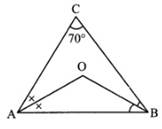
In ∆ABC,
∠BAC + ∠ABC + ∠ACB = 180°
… [Sum of the measures of the angles of a triangle is 180°]
∴ ∠BAC + ∠ABC + 70° = 180°
∴ ∠BAC + ∠ABC = 180° - 70°
∴ ∠BAC + ∠ABC = 110°
∴ ½ (∠BAC) + ½ (∠ABC) = ½ × 110°
… [Multiplying both sides by ½]
∴ ∠OAB + ∠OBA = 55° … (III) [From (I) and (II)]
In ∆OAB,
∠OAB + ∠OBA + ∠AOB = 180°
… [Sum of the measures of the angles of a triangle is 180°]
∴ 55° + ∠AOB = 180° … [From (III)]
∴ ∠AOB = 180° - 55°
∴ ∠AOB = 125°
Solution 8
Given: line AB || line CD and line PQ is the transversal.
Ray PT and ray QT are the bisectors of ∠BPQ and ∠PQD respectively.
To prove: m∠PTQ = 90°
Proof:
∠TPB = ∠TPQ = ½ ∠BPQ … (I) [Ray PT bisects ∠BPQ]
∠TQD = ∠TQP = ½ ∠PQD … (II) [Ray QT bisects ∠PQD]
Since, line AB || line CD and line PQ is their transversal.
∴ ∠BPQ + ∠PQD = 180° … [Interior angles]
∴ ½ (∠BPQ) + ½ (∠PQD) = ½ × 180° … [Multiplying both sides by ½]
∴ ∠TPQ + ∠TQP = 90°
In ∆PTQ,
∠TPQ + ∠TQP + ∠PTQ = 180°
… [Sum of the measures of the angles of a triangle is 180°]
∴ 90° + ∠PTQ = 180° … [From (III)]
∴ ∠PTQ = 180° - 90°
∴ m∠PTQ = 90°
Solution 9
∠c + 100° = 180° … [Angles in a linear pair]
∴ ∠c = 180° - 100°
∴ ∠c = 80° … (I)
∠b = 70° … (II) [Vertically opposite angles]
∠a + ∠b + ∠c = 180°
… [Since, sum of the measures of the angles of a triangle is 180°]
∴ ∠a + 70° + 80° = 180°
∴ ∠a = 180° - 70° - 80°
∴ ∠a = 30° … (III)
∴ ∠a = 30°, ∠b = 70°, ∠ c = 80°
Solution 10
(i)
∠DEG = ∠FEG = x° … (I) [Ray EG bisects ∠DEF]
∠GFD = ∠GFM = y° … (II) [Ray FG bisects ∠DFM]
Since, line DE || line GF and DF is their transversal.
∴ ∠EDF = ∠GFD … [Alternate angles]
∴ ∠EDF = y° … (III) [From (II)]
Since, line DE || line GF and EM is their transversal.
∴ ∠DEF = ∠GFM … [Corresponding angles]
∴ ∠DEG + ∠FEG = ∠GFM … [Angle addition property]
∴ x° + x° = y° … [From (I) and (II)]
∴ 2x° = y°
∴ x° = ½ y°
∴ ∠DEG = ½ ∠EDF … [From (I) and (III)]
(ii)
Since, line DE || line GF and GE is their transversal.
∴ ∠DEG = ∠FGE … (IV) [Alternate angles]
∴ ∠FEG = ∠FGE … (V) [From (I) and (IV)]
∴ In ∆FEG,
∠FEG = ∠FGE … [From (V)]
∴ EF = FG … [Converse of isosceles triangle theorem]
Triangles Exercise 3.2
Solution 1(i)

By SSS test
∆ ABC ≅ ∆ PQR
Solution 1(ii)
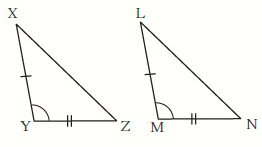
By SAS test
∆ XYZ ≅ ∆ LMN
Solution 1(iii)

By ASA test
∆ PRQ ≅ ∆ STU
Solution 1(iv)
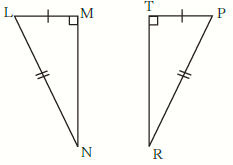
By hypotenuse side test
∆ LMN ≅ ∆ PTR
Solution 2(i)
From the information shown in the figure,
in ∆ ABC and ∆ PQR
∠ABC ≅ ∠PQR
seg BC ≅ seg QR
∠ACB ≅ ∠PRQ
∴ ∆ABC ≅ ∆PQR .......![]() test
test
∴ ∠BAC ≅ ![]() ....... Corresponding angles of congruent triangles.
....... Corresponding angles of congruent triangles.
seg AB ≅![]() and
and ![]() ≅ seg PR …… corresponding sides of congruent triangles
≅ seg PR …… corresponding sides of congruent triangles
Solution 3
In ∆BAC and ∆PQR,
seg BA ≅ seg PQ
seg BC ≅ seg PR
∠BAC ≅ ∠PQR = 90° … [Given]
∴ ∆BAC ≅ ∆PQR … [Hypotenuse side test]
∴ seg AC ≅ seg QR … [C.S.C.T]
∠ABC ≅ ∠QPR and ∠ACB ≅ ∠QRP … [C.A.C.T]
Solution 4
In ∆LMN and ∆PNM,
seg LM ≅ seg PN
seg LN ≅ seg PM … [Given]
seg MN ≅ seg NM … [Common side]
∴ ∆LMN ≅ ∆PNM … [SSS test]
Since, corresponding angles of congruent triangles are congruent
∴ ∠LMN ≅ ∠PNM,
∠MLN ≅ ∠NPM, and
∠LNM ≅ ∠PMN
Solution 5
In ∆ABD and ∆CBD,
seg AB ≅ seg CB
seg AD ≅ seg CD … [Given]
seg BD ≅ seg BD … [Common side]
∴ ∆ABD ≅ ∆CBD … [SSS test]
Solution 6
In ∆PQT and ∆RQS,
∠P ≅ ∠R … [Given]
seg PQ ≅ seg RQ … [Given]
∠Q ≅ ∠Q … [Common angle]
∴ ∆PQT ≅ ∆RQS … [By ASA test]
Solution 2(ii)
From the information shown in the figure,
In ∆ PTQ and ∆ STR
seg PT ≅ seg ST
∠PTQ ≅ ∠STR ... Vertically opposite angles
seg TQ ≅ seg TR
Triangles Exercise 3.3
Solution 1
∠ACB = 50° … [Given]
In ∆ABC, seg AC ≅ seg AB … [Given]
∴ ∠ABC ≅ ∠ACB … [Isosceles triangle theorem]
∴ x = 50° … (I)
∠DBC = 60° … [Given]
In ABDC, seg BD ≅ seg DC … [Given]
∴ ∠DCB ≅ ∠DBC … [Isosceles triangle theorem]
∴ y = 60° … (II)
∠ABD = ∠ABC + ∠DBC … [Angle addition property]
= 50° + 60°
∴ ∠ABD = 110° … (III)
∠ACD = ∠ACB + ∠DCB … [Angle addition property]
= 50° + 60°
∴ ∠ACD = 110° … (IV)
Solution 2
Given: Length of hypotenuse = 15
In a right angled triangle, the length of the median on the hypotenuse is half the length of the hypotenuse
∴ Length of median on the hypotenuse = ½ × length of hypotenuse
= ½ × 15
= 7.5
∴ The length of the median on the hypotenuse is 7.5 units.
Solution 3
Given: PQ = 12, QR = 5
In APQR, ∠Q = 90° … (Given)
∴ PR2 = QR2 + PQ2 … [Pythagoras theorem]
= 25 + 144
∴ PR2 = 169
Taking square root of both sides
∴ PR = 13 units … (I)
Now, in right angled PQR, seg QS is the median on hypotenuse PR.
So, by using the property i.e. In a right angled triangle, the length of the median on the hypotenuse is half the length of the hypotenuse, we have
QS = ½ PR
= ½ × 13
∴ l(QS) = 6.5 units
Solution 4
In ∆PQR, G is the point of concurrence of the medians.
The centroid divides each median in the ratio 2 : 1.
PG : GT = 2 : 1

∴ PG = 2 × 2.5
∴ PG = 5 units
Now, PT = PG + GT [P - G - T]
= 5 + 2.5
∴ l(PG) = 5 units, l(PT) = 7.5 units
Triangles Exercise 3.4
Solution 1
Given: AX = 2 cm
Since, point A lies on the bisector of ∠XYZ.
Also, every point on the bisector of an angle is equidistant from the sides of the angle.
∴ Point A is equidistant from the sides of ∠XYZ.
∴ AZ = AX
∴ AZ = 2 cm
Solution 2
Given: seg PT ⊥ ray ST, seg PR ⊥ ray SR and seg PR ≅ seg PT
Also, ∠RSP = 56° … (Given)
Any point equidistant from the sides of an angle is on the bisector of the angle.
∴ Point P lies on the bisector of ∠TSR
∴ Ray SP is the bisector of ∠RST.
∴ ∠RSP = ½ ∠RST
= ½ × 56°
∴ ∠RSP = 28°
Solution 3
In ∆PQR,
PQ = 10 cm, QR = 12 cm, PR = 8 cm … [Given]
Since, 12 > 10 > 8
∴ QR > PQ > PR
∴ ∠QPR > ∠PRQ > ∠PQR … [Angle opposite to greater side is greater]
∴ In ∆PQR, ∠QPR is the greatest angle and ∠PQR is the smallest angle.
Solution 4
In ∆FAN,
∠F + ∠A + ∠N = 180°
… [Sum of the measures of the angles of a triangle is 180°]
∴ 80° + 40° + ∠N = 180°
∴ ∠N = 180° - 80° - 40°
∴ ∠N = 60°
Since, 80° > 60° > 40°
∴ ∠F > ∠N > ∠A
∴ AN > FA > FN [Side opposite to greater angle is greater]
∴ In ∆FAN, AN is the greatest side and FN is the smallest side.
Solution 5
∆ABC is an equilateral triangle.
To prove: ∆ABC is equiangular
i.e. seg AB ≅ seg BC ≅ seg AC … (I) [Sides of an equilateral triangle]
In ∆ABC,
seg AB ≅ seg BC … [From (I)]
∴ ∠C ≅ ∠A … (II) [Isosceles triangle theorem]
In ∆ABC,
seg BC ≅ seg AC … [From (I)]
∴ ∠A ≅ ∠B … (III) [Isosceles triangle theorem]
∴ ∠A ≅ ∠B ≅ ∠C … [From (II) and (III)]
∴ ∆ABC is equiangular.
Solution 6
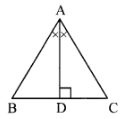
Given: Seg AD is the bisector of ∠BAC and seg AD ⊥ seg BC
To prove: ∆ABC is an isosceles triangle.
Proof:
In ∆ABD and ∆ACD,
∠BAD ≅ ∠CAD … [seg AD is the bisector of ∠BAC]
seg AD ≅ seg AD … [Common side]
∠ADB ≅ ∠ADC … [Each angle is of measure 90°]
∴ ∆ABD ≅ ∆ACD … [ASA test]
∴ seg AB ≅ seg AC … [C.S.C.T.]
∴ ∆ABC is an isosceles triangle.
Solution 7
In ∆PQR,
seg PR ≅ seg PQ … [Given]
∴ ∠PQR ≅ ∠PRQ … (I) [Isosceles triangle theorem]
Since, ∠PRQ is the exterior angle of ∆PRS.
∴ ∠PRQ > ∠PSR … (II) [Property of exterior angle]
∴ ∠PQR > ∠PSR … [From (i) and (ii)]
i.e. ∠Q > ∠S … (III)
In ∆PQS,
∠Q > ∠S … [From (III)]
∴ PS > PQ … [Side opposite to greater angle is greater]
∴ seg PS > seg PQ
Solution 8
In ∆ADB and ∆BEA,
seg BD ≅ seg AE … [Given]
∠ADB ≅ ∠BEA = 90° … [Given]
seg AB ≅ seg BA … [Common side]
∴ ∆ADB ≅ ∆BEA … [Hypotenuse-side test]
∴ seg AD ≅ seg BE … [C.S.C.T.]
Triangles Exercise 3.5
Solution 1
Given: ∆XYZ ~ ∆LMN
∴ ∠X ≅ ∠L, ∠Y ≅ ∠M, ∠Z ≅ ∠N … [Corresponding angles of similar triangles]
Also, the corresponding sides of similar triangles are in the same ratio.
![]()
Solution 2
Given: ΔXYZ ~ ΔPQR
So, the corresponding sides of these triangles will be in the same ratio
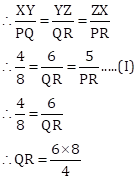
∴ QR = 12 cm
From (I), we have

∴ PR = 10 cm
Thus, the lengths of the sides QR and PR are 12 cm and 10 cm respectively.
Solution 3
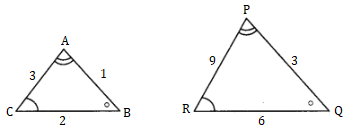
ΔABC ~ ΔPQR
Triangles Exercise 3
Solution 5
In ∆PQS,
PQ + QS > PS … (I)
… [Sum of any two sides of a triangle is greater than the third side]
Similarly, in ∆PSR,
PR + SR > PS … (II)
… [Sum of any two sides of a triangle is greater than the third side]
∴ PQ + QS + PR + SR > PS + PS
∴ PQ + QS + SR + PR > 2PS
∴ PQ + QR + PR > 2PS … [Q-S-R]
Solution 6
Given: Bisector of ∠BAC intersects side BC at point D.
To prove: AB > BD
Proof:
∠BAD ≅ ∠DAC … (I) [Seg AD bisects ∠BAC]
∠ADB is the exterior angle of ∆ADC.
∴ ∠ADB >∠DAC … (II) [Property of exterior angle]
∴ ∠ADB >∠BAD … (III) [From (I) and (II)]
In ∆ABD,
∠ADB >∠BAD … [From (III)]
∴ AB >BD … [Side opposite to greater angle is greater]
Solution 7
Given: Seg PT is the bisector of ∠QPR.
To prove: PS = PR
Construction: Draw seg SR || seg PT.
Proof:
Given: seg PT is the bisector of ∠QPR
∴ ∠QPT = ∠RPT … (I)
Now, seg PT || seg SR and seg QS is their transversal.
∴ ∠QPT = ∠PSR … (II) [Corresponding angles]
Again, seg PT || seg SR and seg PR is their transversal.
∴ ∠RPT = ∠PRS … (III) [Alternate angles]
∴ ∠PRS = ∠PSR … (IV) [From (I), (II) and (III)]
In ∆PSR,
∠PRS = ∠PSR … From (IV)
∴ PS = PR … [Converse of isosceles triangle theorem]
Solution 8
Given: seg AD ⊥ seg BC and seg AE is the bisector of ∠CAB.
To prove: ∠DAE = ½ (∠C - ∠B)
Proof:
∴ ∠CAE = ½ ∠A … (I) [Since, seg AE is the bisector of ∠CAB]
In ∆DAE,
∠DAE + ∠ADE + ∠AED = 180°
… [Sum of the measures of the angles of a triangle is 180°]
∴ ∠DAE + 90° + ∠AED = 180° … [∵ AD ⊥ BC]
∴ ∠DAE = 180° - 90° - ∠AED
∴ ∠DAE = 90° - ∠AED … (II)
In ∆ACE,
∠ACE + ∠CAE + ∠AEC = 180°
… [Sum of the measures of the angles of a triangle is 180°]
∠C + ½ ∠A + ∠AED = 180° [From (I) and C-D-E]
∴ ∠AED = 180° - ∠C - ½ ∠A … (III)
Substituting this value of ∠AED in (II)
∴ ∠DAE = 90° - 180° + ∠C + ½ ∠A
∴ ∠DAE = ∠C + ½ ∠A - 90° … (IV)
Now, in ∆ABC,
∠A + ∠B + ∠C = 180°
Dividing both sides by 2
![]()
![]()
![]()
![]()
![]()
Triangles Exercise Problem set 3
Solution 1(i)
(D)
We know that, sum of any two sides of a triangle is greater than the third side.
But for 1.5 cm and 3.4 cm,
1.5 + 3.4 = 4.9 cm < 5 cm
So, the third side can't be 3.4 cm.
Solution 1(ii)
(B)
In ΔPQR, ∠R > ∠Q
Since, the side opposite to greater angle is greater.
∴ PQ >PR
Solution 1(iii)
(B)
Given: ∠T = 65°, ∠P = 95°
∴ 65° < 95°
∴ ∠T < ∠P
Since, the side opposite to smaller angle is smaller.
∴ PQ
Solution 2
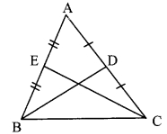
Given: AB = AC, seg BD and seg CE are the medians of ∆ABC
To prove: BD = CE
Proof:
AE = ½ AB … (I) [E is the midpoint of side AB]
AD = ½ AC … (II) [D is the midpoint of side AC]
Also, AB = AC … (III) [Given]
∴ AE = AD … (IV) [From (I), (II) and (III)]
In ∆ADB and ∆AEC,
seg AB ≅ seg AC … (Given)
∠BAD ≅ ∠CAE … (Common angle)
seg AD ≅ seg AE … From (IV)
∴ ∆ADB ≅ ∆AEC
∴ seg BD ≅ seg CE … [CPCT]
∴ BD = CE
Solution 3
Given: In APQR, PQ > PR and bisectors of ∠Q and ∠R intersect at S.
To prove: SQ > SR
Proof:
∠SQR = ½ ∠PQR … (I) [Ray QS bisects ∠PQR]
∠SRQ = ½ ∠PRQ … (II) [Ray RS bisects ∠PRQ]
In ∆PQR,
PQ > PR … Given
∴ ∠R > ∠Q … Angle opposite to greater side is greater
∴ ½ (∠R) > ½ (∠Q) … Multiplying both sides by ½
∴ ∠SRQ >∠SQR … (III) [From (I) and (II)]
∴ In ∆SQR, ∠SRQ >∠SQR … From (III)
∴ SQ >SR … [Side opposite to greater angle is greater]
Solution 4
Given: Points D and E are on side BC of ∆ABC, such that BD = CE and AD = AE.
To prove: ∆ABD ≅ ∆ACE
Proof:
In ∆ADE,
seg AD = seg AE … Given
∴ ∠AED = ∠ADE … (I) [Isosceles triangle theorem]
Now, ∠ADE + ∠ADB = 180° … (II) [Angles in a linear pair]
Also, ∠AED + ∠AEC = 180° … (III) [Angles in a linear pair]
∴ ∠ADE + ∠ADB = ∠AED + ∠AEC … [From (II) and (III)]
∴ ∠ADE + ∠ADB = ∠ADE + ∠AEC … [From (I)]
∴ ∠ADB = ∠AEC … (IV) [Eliminating ∠ADE from both sides]
In ∆ABD and ∆ACE,
seg BD ≅ seg CE … (Given)
∠ADB = ∠AEC … From (IV)
seg AD ≅ seg AE … (Given)
∴ ∆ABD ≅ ∆ACE … (SAS test)

